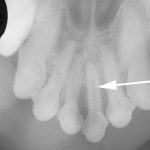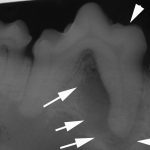The Importance of Veterinary Dental Radiology
Dental radiology is the core diagnostic modality for veterinary dental care. Trying to diagnose and treat dental disease without radiographs is like trying to treat ear disease without an otoscope, or diabetes mellitus without blood glucose measurements.
If a practice is not currently taking dental radiographs, they are sending many, if not most, of their patients home with painful dental problems. Unfortunately, the pets seem to act fine, they eat well according to the owners, and rarely do they show any overt sign that they are in pain. Many owners assume that because there is no obvious pain, there is no pathology. Many veterinarians assume that unless a tooth is loose, it does not require treatment. Nothing could be further from the truth. The accompanying dental radiographs all illustrate cases where non-mobile teeth in apparently normal patients are associated with significant pathology. When these types of problems are found and addressed, the patients typically act “years younger”, according to the owners. If you start taking dental radiographs and treating the hidden disease in your patients, you will likely find that the majority of your positive client comments are generated from your dental cases.
The cost for implementing dental radiology is minimal. New dental X-ray machines are available for around $3500. I would recommend avoiding older human dental X-ray units, as there can be issues with inconsistent exposure times and radiation scatter. An additional $300 gets you a chairside developing tank, film, film clips, and chemistry. Most practices will be happiest using D-speed X-ray film, which provides high detail and is more forgiving of errors in exposure and processing. To save time, a small X-ray view box should be located next to the chairside developer. You should be able to pay for your entire dental radiology investment of around $4000 in one month. You will realize income from the dental radiographs, as well as from the treatment of otherwise hidden pathology. What other area of veterinary medicine provides this kind of return?
A more recent advancement in dental radiology is the availability of digital systems, which eliminate the need for film and chemistry. Digital systems typically range from $7000 to $16,000 in cost, and represent the wave of the future for many practices. Images are organized in a database, and must be backed up regularly to prevent loss of patient records. Some digital imaging software allows for the easy importing of high-quality pictures, printing of client letters with radiographs and pictures, and displaying images from the pet on a large screen in the exam room. Owners love seeing pictures and radiographs from their pet!
The idea of dental radiology is a new one for many practitioners and their clients. You will have to invest a few hours of time and staff training to achieve good results, but the rewards in improved patient health, client satisfaction, and practice revenue will be enormous. I have yet to find one practice, regardless of size, location, or socioeconomic status of their clientele that has failed to successfully implement dental radiology if they tried it.



